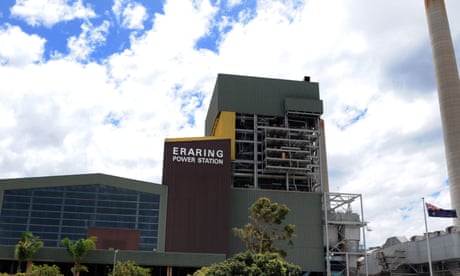Extract from The Guardian
The shift to a grid that runs on renewables is a manageable transformation, but the federal government’s approach still frustrates.

Last modified on Fri 18 Feb 2022 06.59 AEDT
Angus Taylor was refreshingly upfront on Thursday about the extent to which he was sidelined from a major decision affecting the future of Australia’s electricity grid.
Speaking to Ray Hadley on Sydney’s 2GB, the federal energy minister said he did not find out about Origin Energy’s decision to shut Australia’s biggest electricity generator, the Eraring coal-fired power plant, seven years earlier than scheduled until the night before.
“To find out last night with no warning … I’ve got to tell you, it’s very disappointing,” Taylor said.
His New South Wales Liberal counterpart, Matt Kean, also expressed disappointment in Origin’s decision to close the Lake Macquarie plant from 2025, but not shock. He and the company’s chief executive, Frank Calabria, said dialogue between the state government and Origin started months ago.
The first contact from the company was in July, and the company requested it be kept confidential. Which, among other things, meant the federal government wasn’t to be told.

Origin says there is nothing in this – that the NSW government was the relevant jurisdiction for it to talk with – but it’s no secret that major energy industry players are frustrated with what many see as the federal government’s obstructive and scolding approach to dealing with the historic change under way in how electricity is generated and transmitted.
It’s also no secret that Kean and Taylor don’t see eye-to-eye on the best way ahead on electricity. Where the NSW minister talks up the need to act on the climate crisis and promises the country’s biggest renewable energy expansion under legislation passed with cross-party support, Taylor says little about the damage from rising greenhouse gas emissions and mostly emphasises the risks of price spikes and reliability issues in moving away from fossil fuels.
It’s important to note those risks are real. No one should assume the shift to a grid that runs overwhelmingly on renewable energy will be straightforward. But emphasis matters, and plenty of experts – from the Australian Energy Market Operator (Aemo) down – say the transformation is manageable.
Taylor’s admission he was kept out of the loop on one of biggest decision affecting the electricity grid in recent times suggests Origin learned from the experience of others, particularly AGL. Those lessons include that to be open with the federal government that you plan to shut a coal plant early is to invite pressure to keep it running.
The Morrison government’s approach to energy remains piecemeal and inconsistent. It includes building publicly owned hydro and gas plants that discourage private investment while maintaining it is the industry’s responsibility to provide the generation needed. There is no national policy to guide when ageing coal plants should close, or to support coal communities that face inevitable disruption.
Instead, some politicians continue to play out a strange pantomime, pretending the country’s official schedule of coal-plant closure dates – which would see many running well into the 2030s, and some the 2040s – remains a meaningful document. In reality, it is widely accepted that many could shut much earlier.
Why? The rise of solar has rapidly made coal plants unviable as the around-the-clock generators they were meant to be. They can’t compete with an influx of free solar energy in the middle of the day, and were mostly not built to ramp down and then back up when needed. This was the point Calabria was making when he said “rapidly changing conditions in the national electricity market” are “increasingly not well suited to traditional baseload power stations”.
Coal still provides about 60% of generation in the grid and is crucial for its operation, but renewables are coming fast: from about 20% three years ago to more than 31% last year, and 35% in the December quarter.
That should reach 69% by the end of the decade, according to federal government projections. Labor, meanwhile, has a $20bn pledge to bring forward the construction of transmission infrastructure to connect new renewable energy zones. Modelling for the ALP suggests the country could hit 83% renewable energy by 2030 if it wins the upcoming election. How many coal plants does that leave room for?
The role of supporting cheap variable solar and wind is expected to increasingly be played by things better suited to filling the gaps. They include batteries, pumped hydro schemes, stronger transmission connections, demand management programs and, at least for a while, gas-fired plants.
Aemo laid this out in its draft integrated system plan – a blueprint for an optimal grid – in December, when it suggested the step change under way meant coal plants were likely to shut at almost triple the pace officially acknowledged, and estimated the new generation needed to meet future demand.
It is not the only view of the future, but nothing in the weeks since has challenged its view that coal is rapidly headed for the door. Two energy giants – AGL last week, and now Origin – have brought forward coal plant official closure dates and renewables have pushed black coal generation to its lowest levels in 23 years.
Eraring is particularly in the gun. As Dylan McConnell, a University of Melbourne energy analyst, points out, it is generally the most expensive coal generator in the grid and its output has fallen more rapidly than the rest of the fleet. It is the sort of decline that might grab a federal energy minister’s attention whether directly informed or not.
There are two immediate questions that flow from the announcement of Eraring’s exit. The first is whether the NSW government’s response is up to the task.
On support for the plant’s 400 workers and the community that relies, it’s too early to say. Both the company and the state government have promised packages, with details to come.
On electricity supply, Kean announced the creation of a “transmission acceleration facility” charged with hurrying up the investment being driven by the electricity infrastructure roadmap that passed state parliament in 2020. Its first mission is building a 700MW “Waratah super battery” with a proposed storage capacity of 1400 megawatt hours.
Taylor told Hadley it was “delusional” to think a battery could replace a 2880MW coal plant, but Kean said that was not its role – that it would be designed to fix constraints in getting existing generation to Sydney, Newcastle and Wollongong, not provide energy itself. There was also $84m to bring forward other infrastructure and nearly $50m for pumped hydro projects.
Is it enough? It’s early days and some analysts have expressed concern, but Aemo was quick to make its position clear: the state would have access to enough electricity to ensure its energy security target – set to ensure the lights stay on even in disastrous circumstances – could still be met once Eraring is gone.
Which is good news – and brings us to the second question. When should we expect the next announcement that a coal plant is closing early?
It would be unwise to bet it will take long.
No comments:
Post a Comment